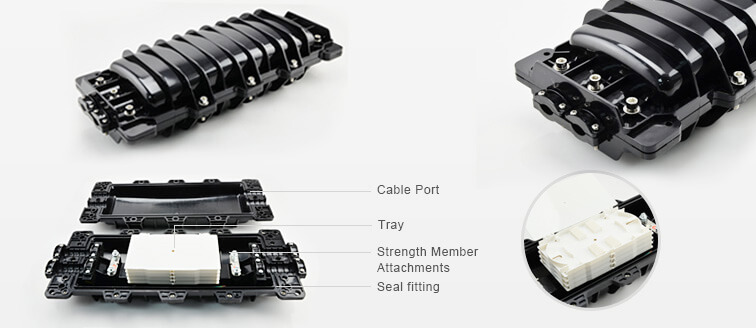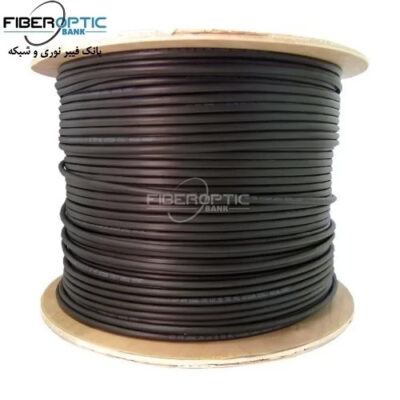Fiber Optic Closure
Fiber optic closure, also known as fiber optic splicing closures, is a device used to provide space and protection for fiber optic cables spliced together. The fiber optic closure connects and stores optical fibers safely either in the outside plant or indoor buildings. It can provide protection for the fiber joint and the fiber cables since they have excellent mechanical strength and strong out shell, which ensures the joints are not damaged by the hostile environment.
Types of Fiber Optic Closure
No matter the size, types, and configuration of your network, protecting the connectivity is what counts. According to different applications, there are various types of fiber optic closures in the market for users to choose from and help them protect their networks.
Horizontal Type Fiber Optic Closure
Horizontal type fiber closure is like a flat or cylindrical case. This type of fiber splice closure is the most commonly used one in mounted aerials or buried underground. Horizontal type fiber optic closure usually contains one or more fiber splice trays to provide space and protection for fiber optic splices. Fiber splice trays used in different fiber optic splice closures may have different designs and fiber counts. The common fiber counts of flat fiber splice closure are 12 and 24 fibers.
Horizontal fiber optic splice closures are designed to be waterproof and dustproof. They have good adaptability and compression resistance, for they are commonly made of high tensile construction plastic. If attached to a pole or hung from wiring, these fiber splice closures need to be held firmly in place, to avoid damage from weather and wind.
The following picture shows a 96-fiber horizontal fiber optic splice closure. It has two input ports and two output ports providing space for 96 fiber splices. There are four standard 24-fiber splice trays stacked together inside the fiber optic splice closure.
Vertical Type Fiber Optic Closure
Vertical fiber optic closure looks like a dome, thus it is also called dome fiber optic splice closure or fiber dome closure. The dome shape makes it easy to be buried in many applications, though it also can be used above-ground as well.
Due to the growing network demands, there is a wide range of models and configurations of vertical fiber optic splice closures. High-capacity versions and variations in the number of splicing trays are also available in the market to meet the complex needs of today’s fiber-optic networks. The number of inlet/outlet ports of the dome fiber optic closure also varies with application needs. Dome fiber optic splice closure requires high-levels seals and waterproof technology, due to its underground applications. Besides, keeping insects and dirt out is also important for underground closures.
The following shows a vertical type splice closure which has five entries providing up to 24 fiber optic splices in two 12-fiber splice trays. Different from the above one, the internal fiber splice tray here is suitable for the vertical design of the fiber splice closure.
Factors to Consider When Choosing Fiber Optic Closure
The optical network structure is often complex, especially the optical access part has unique requirements to function well. A reliable fiber optic splice closure will eliminate lots of unnecessary issues. For example, for the network distribution system, a long-lasting, durable optical closure can avoid frequent check of the access link part. And as the network reaches the distribution stage and drop lines, a splice closure that allows adding more connections will be great. The following factors will help you to choose the right fiber optic splice closures and protect the fiber optics in your network.
1. Cable Compatibility
A good fiber optic closure shall be capable of accepting any fiber optic cable as specified in the tender document. Thus, it is vital to figure out cable compatibility before selecting the right closure type. The design of fiber optic splice closure changes with the application areas. Therefore, a fiber optic splice closure for aerial will have a different design from that used for the underground application.
2. Numbers of Cable Ports
The cable port is also known as the cable entrance capacity. The number of ports in a fiber optic closure reflects its capacity to handle the number of cables. The cable entrance capacity of a fiber optic splice closure refers to the number of ports available for terminating cable within the closure. The number of ports provided in a closure depends on factors such as the network capacity and the number of cables employed in the network. Usually, in an attempt to reduce the physical size of high-capacity closures, smaller ports shall be utilized for branch cables and drop cables.
3. Termination System
Before choosing the splice closure type, the cable termination system should be designed to provide sufficient mechanical strength between the cable and closure to ensure its performance throughout the lifetime. The materials used for fiber optic splice closures shall also be capable of minimizing or negating the effects of relative motion between cable components because the materials used in optical fibers are easy to thermal expansion and contraction.
4. Types of Splices
The splice trays within the fiber optic splice closure can’t hold enough cables if the cables do not be spliced properly. Usually, ribbon or mechanical splices have a larger size, which may lead to capacity loss of the closure trays. A suitable configuration of the splices can avoid installation problems and help improve performance. Therefore, the types of splices should be considered when choosing a fiber splice closure.
5. Bonding & Grounding
Proper bonding and grounding of conductive elements of the optical network shall be provided for the safe deployment and operation of the network.
6. Hardware and Accessors
Aerial fiber optic closures may need to hang on the messenger wire depending on the network configuration. Or they may be attached to the pole. In both cases, extra hardware is required along with the closures. The hardware or accessories to attach and secure should be able to bear wear and tear and also environmental stresses.
7. Cable Management
Keeping a low bend radius in fiber cables installations is important. The link performance may be affected if this factor is ignored. A fiber optic closure that can support well cable management should be considered when making a choice. And splice closures that allow for easy installation can eliminate excessive stress or damage during handling.
Source: community.fs
Related products...
fiber-optic-cable
fiber-optic-cable
fiber-optic-cable

















[ratings]